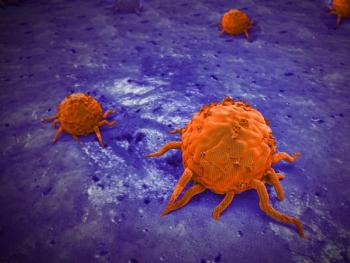
Survival in Metastatic Lung Cancer Improved With SBRT Before Maintenance Chemo
Undergoing SBRT prior to starting maintenance chemotherapy significantly improved progression-free survival in patients with limited metastatic non–small-cell lung cancer, according to the results of a phase II study presented at the ASTRO Annual Meeting.
Undergoing stereotactic body radiation therapy (SBRT) prior to starting maintenance chemotherapy significantly improved progression-free survival (PFS) in patients with limited metastatic non–small-cell lung cancer (NSCLC), according to the results of a phase II study (abstract LBA-3) presented at the American Society for Radiation Oncology (ASTRO) Annual Meeting, held September 24–27 in San Diego.
“Even in the era of immunotherapy, there are not large numbers of metastatic NSCLC patients with durable responses to systemic therapy,” said Puneeth Iyengar, MD, PhD, lead author of the study and an assistant professor of radiation oncology at the University of Texas Southwestern Medical Center in Dallas, in a
“This finding suggests that local treatments, including radiation, could work in concert with chemotherapy to prolong the amount of time before recurrence occurs in patients with limited sites of metastatic NSCLC,” he said.
The small study included 29 patients with stage IV NSCLC limited to six or fewer sites (including primary). Patients had responded at least partially to first-line/induction chemotherapy. The patients were randomly assigned to maintenance chemotherapy with or without consolidative SBRT to all sites of disease.
Radiation to metastases was offered as a single fraction (to 21–27 Gy), three fractions (to 26.5–33 Gy), or five fractions (to 30–37.5 Gy) of SBRT (regimens were biologically equivalent). Radiation to the primary disease site was delivered to a total dose of 45 Gy via SBRT where possible, or through 15 fractions of hypofractionated radiation therapy if the primary tumor was too central or involved mediastinal nodes. Maintenance chemotherapy was left to the discretion of the treating medical oncologists and consisted of pemetrexed, docetaxel, erlotinib, or gemcitabine.
The median follow-up was 9.6 months. The trial was stopped early when an unplanned interim analysis showed that the PFS in patients undergoing SBRT was more than double that of patients going directly to maintenance chemotherapy (9.7 vs 3.5 months; hazard ratio [HR], 0.304; 95% CI, 0.113–0.815; P = .01).
The rates of local control and delay in distant metastases also favored SBRT plus maintenance chemotherapy. Patients who underwent SBRT had no recurrences in original sites of gross disease compared with seven failures in original sites of gross disease in the arm receiving only maintenance therapy. At the time of analysis, 10 of the 15 patients receiving maintenance chemotherapy only had progressed compared with 4 of the 14 patients also receiving radiation. None of the recurrences among the latter patients were in areas treated directly with radiation therapy.
“These findings verify that PFS for limited metastatic disease really is no different than it is for widely metastatic disease, suggesting that local therapy could play an important future role in survival outcomes,” said Iyengar. “Moreover, the addition of consolidative radiation did not increase toxicity, which allowed patients to continue on to additional systemic therapy that is important to controlling aggressive metastatic disease.”
Newsletter
Stay up to date on recent advances in the multidisciplinary approach to cancer.


















































































